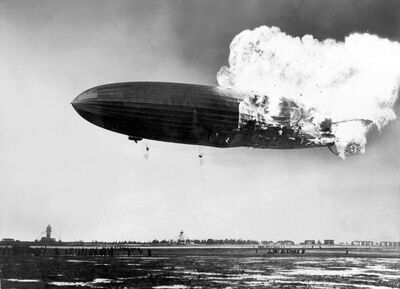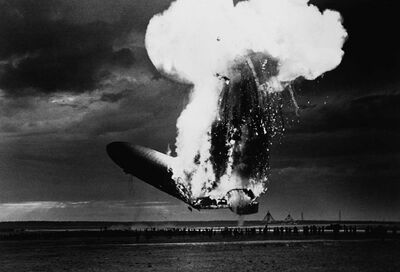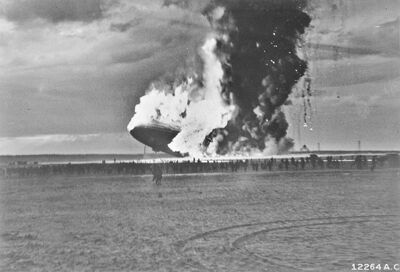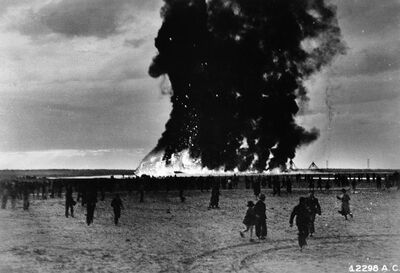No edit summary |
No edit summary |
||
| Line 11: | Line 11: | ||
== Disaster Strikes == |
== Disaster Strikes == |
||
| − | At 7:25, without warning, the Hindenburg's hydrogen caught fire. Small flames ripped through the |
+ | At 7:25, without warning, the Hindenburg's hydrogen caught fire. Small flames ripped through the top of the ship, close [[File:57d17ef2d8f08.image.jpg|thumb|400px|The Hindenburg's stern explodes, 5 seconds after the fire breaks in front of the tail.]]to the tailfins. Five seconds later, the airship was rocked by a tremendous explosion as one of the rear hydrogen gas bags ignited and caught fire. The back of the airship was quickly engulfed in fire, and the ship (as it was losing hydrogen) began to fall to the ground tail-first. The tail's metal ripped, melted, and collapsed as it fell. |
| − | + | The landing crew on the ground scattered for cover. Reporters and civilians underneath the ship screamed and ran away in panic. The huge crowd of reporters and civilians watching the landing from a safe distance broke out screaming as they watched in horror as the airship burned. Other landing crew members ran out onto the field, towards the burning wreckage. |
|
| − | Inside the Hindenburg, chaos took over. In the passenger's lounge and observation decks, tables and chairs slid backward and smashed. The screaming passengers were sent tumbling down as the ship lurched to a high angle. The crew was thrown back |
+ | Inside the Hindenburg, chaos took over. In the passenger's lounge and observation decks, smoke burst through the hallways, the air turned as hot as a furnace, and tables and chairs slid backward and smashed. The screaming passengers were sent tumbling down as the ship lurched to a high angle. The crew was thrown back too, in the gondola. The crew inside the ship's hull ran for their lives as the fire spread. Lots of crew members are burned alive as the fire tears through the Hindenburg. Thick smoke poured through the passenger quarters, followed by flames that began to spread rapidly throughout the passengers quarters as flaming debris fell through the ceiling and into the cabins. Many [[File:Hindenburg-disaster-hull-buckle.jpg|thumb|left|400px|The Hindenburg Falls out of the Sky as the ship's tail is engulfed in fire.]]passengers still inside their cabins were trapped and killed. |
| − | + | One by one each of the hydrogen gas bags ignited or caught fire. Before the Hindenburg hit the ground, another explosion rocked the inside of the ship, as the diesel fuel was ignited by the fire. A horizontal explosion suddenly ripped through, as the diesel fuel caught fire, shooting flames through the nose, and killing almost all the 12 crew members in the nose, with others been severely burnt. As the fire spread on the fabric roof of the ship and flames ripped through the nose, the ship's tail crashed to the ground, crushing land crew member, Allen Hagman, killing him almost instantly. One of the Hindenburg's propellers whipped violently through the air and broke apart as one of the still-idling engines crashed to the ground. |
|
| − | Just before the ship hit the ground, flames tore into the passenger's quarters, setting the lounges on fire, as the cabins continued to burn. Many people were burnt or set on fire. At this point, the passengers began to open and smash the windows on both sides of the ship, to create a method of escaping the fire. Passengers began to jump for their lives around this point. Some people jumped too high, accidentally falling to their deaths. Many others timed their jumps when the ship got lower and lower to the ground. |
+ | Just before the ship hit the ground, flames tore into the passenger's quarters, setting the lounges on fire, as the cabins continued to burn. Many people were burnt[[File:NASM-SI-98-15070.jpg|thumb|400px|The Hindenburg hits the ground as flames shoot out of the nose.]] or set on fire. At this point, the passengers began to open and smash the windows on both sides of the ship, to create a method of escaping the fire. Passengers began to jump for their lives around this point. Some people jumped too high, accidentally falling to their deaths. Many others timed their jumps when the ship got lower and lower to the ground. |
[[File:NASM-SI-98-15066.jpg|thumb|left|400px|The airship's bow begins to burn up.]]The crew members did the same. They opened up emergency exit doors (that had been put on the hull just in case of fire) and jumped to the ground, jumped out of the burning nose, while others ripped through the fabric of the ship before the flames reached them, and fell to the ground. However, almost all of the crew members inside the hull were killed as it became engulfed. Witnesses on the ground reported seeing flaming bodies falling from the burning hull, and some passengers on fire jumping from the windows. |
[[File:NASM-SI-98-15066.jpg|thumb|left|400px|The airship's bow begins to burn up.]]The crew members did the same. They opened up emergency exit doors (that had been put on the hull just in case of fire) and jumped to the ground, jumped out of the burning nose, while others ripped through the fabric of the ship before the flames reached them, and fell to the ground. However, almost all of the crew members inside the hull were killed as it became engulfed. Witnesses on the ground reported seeing flaming bodies falling from the burning hull, and some passengers on fire jumping from the windows. |
||
| Line 40: | Line 40: | ||
==Footage== |
==Footage== |
||
[[File:Hindenburg Disaster Real Zeppelin Explosion Footage (1937) British Pathé|thumb|center|604px]] |
[[File:Hindenburg Disaster Real Zeppelin Explosion Footage (1937) British Pathé|thumb|center|604px]] |
||
| − | |||
| − | |||
[[File:1937-05-10 Hindenburg Zeppelin Explodes, Scores Dead|thumb|center|585 px]] |
[[File:1937-05-10 Hindenburg Zeppelin Explodes, Scores Dead|thumb|center|585 px]] |
||
Revision as of 17:39, 17 May 2019
The Hindenburg Disaster occurred on May 6th, 1937. The world's largest Zeppelin, the LZ 129 Hindenburg was attempting to land at the Lakehurst Naval Air Base in New Jersey after completing it's first Frankfurt-United States transatlantic flight of 1937 and it's 18th transatlantic flight altogether. Suddenly, at 7:25, the airship caught fire, and within 30-40 seconds, the airship was completely destroyed.
36 people were killed by the disaster (35 passengers and one ground crew member).
Flight
Landing Attempt
Disaster Strikes
At 7:25, without warning, the Hindenburg's hydrogen caught fire. Small flames ripped through the top of the ship, close

The Hindenburg's stern explodes, 5 seconds after the fire breaks in front of the tail.
to the tailfins. Five seconds later, the airship was rocked by a tremendous explosion as one of the rear hydrogen gas bags ignited and caught fire. The back of the airship was quickly engulfed in fire, and the ship (as it was losing hydrogen) began to fall to the ground tail-first. The tail's metal ripped, melted, and collapsed as it fell.
The landing crew on the ground scattered for cover. Reporters and civilians underneath the ship screamed and ran away in panic. The huge crowd of reporters and civilians watching the landing from a safe distance broke out screaming as they watched in horror as the airship burned. Other landing crew members ran out onto the field, towards the burning wreckage.
Inside the Hindenburg, chaos took over. In the passenger's lounge and observation decks, smoke burst through the hallways, the air turned as hot as a furnace, and tables and chairs slid backward and smashed. The screaming passengers were sent tumbling down as the ship lurched to a high angle. The crew was thrown back too, in the gondola. The crew inside the ship's hull ran for their lives as the fire spread. Lots of crew members are burned alive as the fire tears through the Hindenburg. Thick smoke poured through the passenger quarters, followed by flames that began to spread rapidly throughout the passengers quarters as flaming debris fell through the ceiling and into the cabins. Many

The Hindenburg Falls out of the Sky as the ship's tail is engulfed in fire.
passengers still inside their cabins were trapped and killed.
One by one each of the hydrogen gas bags ignited or caught fire. Before the Hindenburg hit the ground, another explosion rocked the inside of the ship, as the diesel fuel was ignited by the fire. A horizontal explosion suddenly ripped through, as the diesel fuel caught fire, shooting flames through the nose, and killing almost all the 12 crew members in the nose, with others been severely burnt. As the fire spread on the fabric roof of the ship and flames ripped through the nose, the ship's tail crashed to the ground, crushing land crew member, Allen Hagman, killing him almost instantly. One of the Hindenburg's propellers whipped violently through the air and broke apart as one of the still-idling engines crashed to the ground.
Just before the ship hit the ground, flames tore into the passenger's quarters, setting the lounges on fire, as the cabins continued to burn. Many people were burnt

The Hindenburg hits the ground as flames shoot out of the nose.
or set on fire. At this point, the passengers began to open and smash the windows on both sides of the ship, to create a method of escaping the fire. Passengers began to jump for their lives around this point. Some people jumped too high, accidentally falling to their deaths. Many others timed their jumps when the ship got lower and lower to the ground.

The airship's bow begins to burn up.
The crew members did the same. They opened up emergency exit doors (that had been put on the hull just in case of fire) and jumped to the ground, jumped out of the burning nose, while others ripped through the fabric of the ship before the flames reached them, and fell to the ground. However, almost all of the crew members inside the hull were killed as it became engulfed. Witnesses on the ground reported seeing flaming bodies falling from the burning hull, and some passengers on fire jumping from the windows.
As the ship grew closer and closer to the ground, the area above the passenger quarters began to become engulfed in flames. The ceiling's in the passenger's cabins and lounges began to collapse exposing the hellish flames above, which began to fall into cabins, killing and trapping many of them. Around this time, the crew's gondola crashed to the ground. Captain Pruss and the rest of the crew began to escape by smashing open the windows on the bridge. However, flaming debris fell into the cabin, severely burning Pruss and killing a few members in the gondola.
However, the gondola balanced the ship level for a few seconds, therefore allowing the majority of the passengers to

The Hindenburg is completely engulfed in flames, just before the frame collapses.
escape. However, most people who escape were on the port side of the ship, as a light wind pushed the fires away from the port side, towards the starboard side. The people on the starboard side were far less lucky, as the wind pushed the fire towards them. Many people managed to escape by jumping out the starboard windows, but the fire engulfed the starboard side within seconds, killing most of the people trapped inside the port side. The Hindenburg's logos are completely burned up on the port and starboard side at this point. Also, around the same time, the starboard side began to become engulfed, the loading stairway (where the passengers board or depart the ship) shook open as the ship vibrated, allowing many passengers to escape by climbing down the stairs to the ground, just like disembarking on a normal journey's end. However, the escape stairway became jammed a few seconds later by falling debris, sealing the fate of most of those still trapped on board.

The Hindenburg collapses
As the staircase became jammed, the port side was finally engulfed in flames, killing most of the people still inside, as the final people jumped out the windows. The whole airship was now completely engulfed in flames. A second later, the hydrogen finished burning, though the framework of the ship, the diesel fuel, and everything else still was engulfed. With no hydrogen, gravity took over, and the nose began to fall to the ground, bending the melted frame in the process. As the nose crashed the ground, the Hindenburg collapsed, destroying everything and reducing the airship to a pile of tangled metal.
The whole catastrophe took place in 30-40 seconds.
Aftermath
The ground crew rushed towards the blazing wreckage to save people still trapped inside the wreckage of the Hindenburg, and assist the survivors. The Hindenburg's hydrogen had all burned off, though the diesel fuel was still burning.


